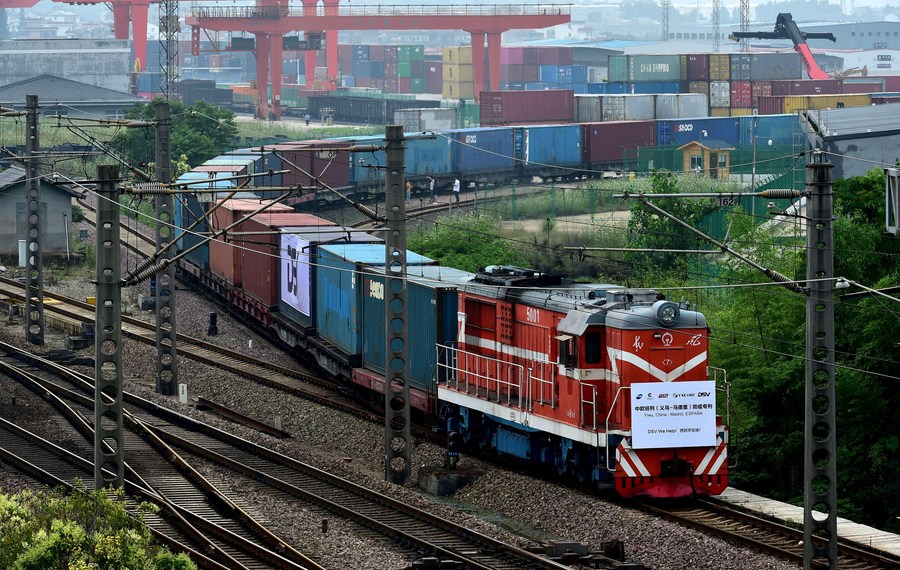
Aerial photo taken on Sept. 14, 2020 shows the view of downtown areas in Shenzhen, south China's Guangdong Province. (Xinhua/Mao Siqian)
BEIJING, Jan. 21 (Xinhua) -- With a strong rebound in the fourth quarter, China ended 2020 with a full-year expansion of 2.3 percent, becoming the only major economy to achieve positive growth in the pandemic-ravaged year.
While some sectors are still feeling the pinch of the COVID-19 outbreak, more have emerged from the negative impacts faster and stronger than expected.
Looking beneath the headline data, the following are some estimate-beating facts and figures on how the various economic segments interplayed to shape up growth for the year.
-- INDUSTRIAL ENGINE
The coronavirus outbreak in Q1 2020 had brought China's industrial activity to a halt. But as soon as the virus spread was largely contained, China gradually and cautiously reopened factories and resumed production, enabling the industrial sector to become the first to stage a rebound.
After returning to growth in April, China's industrial engine continued to forge ahead, stabilizing and driving growth for the broader economy. The value-added industrial output surged 7.1 percent year on year in Q4, accelerating by 1.3 percentage points from Q3 last year.
For the whole year, the indicator went up 2.8 percent year on year.

A China-Europe freight train carrying medical supplies bound for Madrid of Spain departs from the city of Yiwu, east China's Zhejiang Province, June 5, 2020. (Photo by Lyu Bin/Xinhua)
-- FOREIGN TRADE
China emerged from the global economic and trade challenges in 2020 as the world's only major economy to have registered positive growth in the foreign trade of goods.
China's total imports and exports of goods expanded 1.9 percent year on year to 32.16 trillion yuan (about 4.97 trillion U.S. dollars) in 2020, hitting a record high despite a slump in shipments globally.
Exports rose 4 percent, while imports went down 0.7 percent, according to the General Administration of Customs. In December alone, exports surged 10.9 percent year on year in yuan terms.
Trade growth in Chinese exports was initially driven by demand for pandemic-related products such as face masks and computing equipment for remote working, but the recovery has since broadened out, with other shipments now up year on year as well, according to Chris Leung, chief China economist of Singapore-based DBS Bank.
-- DIGITAL ECONOMY
China's booming digital economy played a vital role in stabilizing the overall economy.
Chinese internet and logistics companies have been leveraging their strong technological and supply chain management capabilities, as well as their large user bases, to help contain the virus and facilitate work resumption.
At the policy level, China is stepping up efforts to develop the digital economy and increase investments in "new infrastructure" such as 5G networks and data centers, which is expected to generate new driving forces for the economic recovery from the pandemic.
China's fixed-asset investment steadily recovered in 2020, with the investment in the high-tech industry and private sector rising rapidly, official data showed.
In breakdown, investment in high-tech manufacturing and services jumped 11.5 percent and 9.1 percent year on year, respectively.

Photo taken on April 19, 2020 shows the building site of a 5G base station near the advanced base camp of Mount Qomolangma in southwest China's Tibet Autonomous Region. (China Mobile/Handout via Xinhua)
-- RECORD FDI INFLOW
In 2020, China's foreign investment inflow reached a record high, posting a faster pace of growth and taking up a larger global share despite market projections of a pandemic-triggered contraction across the world.
Foreign direct investment into the Chinese mainland, in actual use, expanded 6.2 percent year on year to a record high of 999.98 billion yuan in 2020, the Ministry of Commerce (MOC) said.
A total of 38,570 new overseas-funded enterprises were established last year, meaning an average of more than 100 firms had been set up every day.
China has become a "stabilizer" and "safe haven" for cross-border investment, contributing to the global economic recovery, the MOC said.
-- POLICY STABILITY
China's fast recovery in 2020 is also attributable to the government's right policy mix, including raising the deficit, tax relief, cuts in lending rates and banks' reserve requirements.
A notable feature is that despite COVID-19 impacts, China has relied more on targeted counter-cyclical adjustments to stimulate the economy instead of resorting to a deluge of stimulus policies.
To maintain stable liquidity while avoiding money flooding the market, China's central bank put more focus on enabling structural policy tools, including re-lending and rediscount programs, to provide liquidity.
China will prioritize stability in its monetary policy and avoid making sudden shifts in 2021, the country's central bank has pledged. ■




